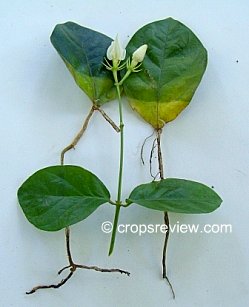Plant propagation is the branch of horticulture that deals with the deliberate (or intentional) production of new plants using various starter materials (e.g. organs, tissues), including their intensive but temporary care.
It is primarily practiced to produce seedlings or clones of nursery crops for outplanting, or for planting in containers for display or decor, or other uses.
Nursery crops are those which commonly require the use of pre-grown planting materials for outplanting, or field planting.
A plant nursery is a place where seedlings, clones, and potted plants are raised temporarily under intensive care.
The basis of plant propagation is totipotency, the capability of cells to regenerate missing parts and, subsequently, an entire organism.
Applied to plants, it means that any live part that is separated from the parent plant is composed of live cells, can possibly produce missing organs of an intact plant, such as roots and shoot, and give rise to an entire plant.
It means that all plant organs with live cells, such as seeds, stems, etc., either intact or segmented, are potential propagules, or propagating materials.
Plant Propagation Methods
In general, there are two methods of propagating plants: sexual and asexual.
Sexual propagation is with the use of a seed or spore that is separated from the parent plant.
This method is so-termed “sexual” because there is the involvement of the sexes, referring to the contribution of both the male and female gametes in the production of new plants.
The propagated plant, therefore, has a genotype that results from combining those which originate from the parental sources of male and female gametes.
Consequently, the resulting plant may exhibit either, or somewhat different, or a combination of parental characteristics.
The young plant that is produced from seed is called seedling while clonal seedling or simply clone is used for that which is vegetatively produced.
However, seedling is now used as a general term to refer to any young plant without regard to the method of propagation.
It does not mean, however, that all plants which are propagated by seed are sexually reproduced.
There are some exceptions, notably the hawkweed (Hieracium sp.) and farm crops like mangosteen (Garcinia mangostana) and lanzones (Lansium domesticum) which produce apomictic seeds.
Apomixis is the production of seeds without sexual union. It also occurs in citrus and polyembryonic mango.
Propagation using apomictic seeds is considered asexual.

(Click on to read function of fruit in plant propagation)
Asexual propagation, also called vegetative propagation, is with the use of planting materials that are vegetative parts of any plant rather than seeds or spores which are reproductive parts.
In most techniques, the propagule is separated first from the parent plant and treated to induce regeneration or otherwise directly planted.
Asexual or vegetative propagation does not involve the union of the male and female gametes.
Both meiosis and fertilization are not required in the production of planting materials and new plants.
Plant propagation involves the use of propagating materials consisting of plant parts that develop through mitotic cell division.
As a result, the new plants, called clones, are genotypic duplicates of the mother plants.
With the inclusion of apomictic seeds, the following vegetative plant organs are used in natural asexual propagation: bulb and bulblet, clove, corm and cormel, tuber and tubercle, rhizome, stolon, slip, sucker, crown, and plantlet.
(Click here to read starchy roots vs. tubers vs. corms)
The following artificial methods of producing clonal seedlings are also employed: propagation by root cutting, stem cutting, leaf-cutting, layering and marcotting, budding, and grafting.
Plant propagation methods can also be divided into two types: conventional and modern.
Conventional propagation is the usual method of plant multiplication using plant organs, such as seeds and stems, under “outside” or outdoor conditions.
Modern propagation is the rapid multiplication of plants with the use of the same plant organs as well as tissues (for example corn embryo, tobacco pith, orchid, and banana meristems) and cells as propagule applying advanced techniques like tissue culture.
Tissue culture also called in vitro culture and micropropagation is the technique of propagating plants indoors under aseptic or sterile conditions in artificial growth media.
The growth medium, also called nutrient solution, is a mixture of essential elements. The initial propagule in tissue culture is called explant.
Seed Propagation and Spore Propagation Compared
Seed propagation is applied in the spermatophytes or seed-bearing plants which include the gymnosperms (naked-seed plants) and the angiosperms (enclosed-seed plants or true-flowering plants).
Plants that are propagated from spore belong to the fern family and allies, including mosses.
(Click to read how we propagated the giant staghorn fern or capa de leon in the backyard)
In-plant propagation using the seed or spore as propagation material, fertilization, or the union of the male and female gametes is a precondition for the production of new plants.
However, there is a difference between the two.
In seeds, a miniature plant (the embryo) within the organ has been predeveloped after undergoing fertilization.
This embryo is the one that grows to form the new plant.
This means that fertilization first occurs (after pollination), and this leads to seed formation.
The seed, having a sexually produced and mature embryo, germinates and gives rise to a seedling.
But in spore propagation, the spore does not immediately develop into a new plant.
The spore is formed without undergoing fertilization.
Under moist conditions, it develops into a gametophyte or “prothallus,” a flat, green, and heart-shaped structure with small rootlike rhizoids.
This organ has both male and female gametes which subsequently unite and give rise to new plants.
In other words, fertilization comes first, the planting material called seed is formed, and then the seed germinates to form the new plant.
But in ferns and other non-seed plants, the planting material called spore is formed first, it develops into a prothallus, fertilization follows, and the fertilized egg develops into a plantlet.
